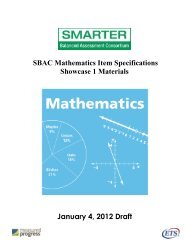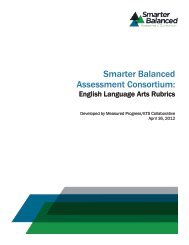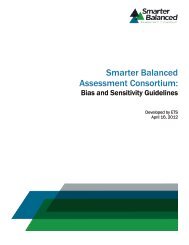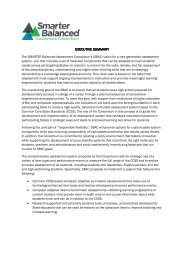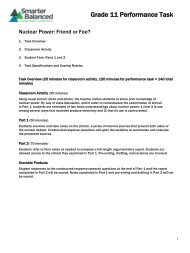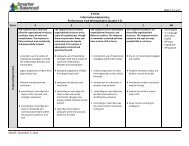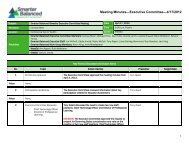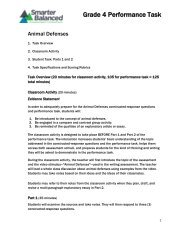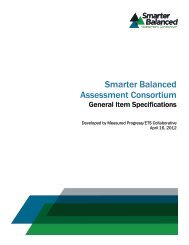Content Specifications for the Summative Assessment of the ...
Content Specifications for the Summative Assessment of the ...
Content Specifications for the Summative Assessment of the ...
You also want an ePaper? Increase the reach of your titles
YUMPU automatically turns print PDFs into web optimized ePapers that Google loves.
systematic (empirical) observation methods and analyses <strong>of</strong> evidence produced in student work samples<br />
from a range <strong>of</strong> assessments.<br />
Observation: A set <strong>of</strong><br />
specifications <strong>for</strong><br />
assessment tasks that will<br />
elicit illuminating responses<br />
from students<br />
Interpretation: The<br />
methods and analytic tools<br />
used to make sense <strong>of</strong> and<br />
reason from <strong>the</strong> assessment<br />
observations/evidence<br />
Cognition: Beliefs about how<br />
humans represent in<strong>for</strong>mation and<br />
develop competence in a particular<br />
academic domain<br />
The <strong>Assessment</strong> Triangle (NRC, 2001, p. 44)<br />
Evidence-based design: SBAC is committed to using evidence-based design in its development <strong>of</strong><br />
assessments in <strong>the</strong> Consortium’s system. The SBAC approach is detailed in <strong>the</strong> following section, but a<br />
brief explanation is as follows. In this document, five “Claims” are declared about what students should<br />
know and be able to do in <strong>the</strong> domain <strong>of</strong> English language arts and literacy. Each claim is accompanied<br />
by a “Rationale” that provides <strong>the</strong> basis <strong>for</strong> establishing <strong>the</strong> claim as central to ELA/Literacy. The<br />
Claims and Rationales represent <strong>the</strong> “cognition” part <strong>of</strong> <strong>the</strong> assessment triangle. For each Claim and<br />
Rationale <strong>the</strong>re is a section representing <strong>the</strong> “observation” corner <strong>of</strong> <strong>the</strong> triangle. Here, a narrative<br />
description lays out <strong>the</strong> kinds <strong>of</strong> evidence that would be sufficient to support <strong>the</strong> claim, which is<br />
followed by tables describing “<strong>Assessment</strong> Targets” linked to <strong>the</strong> Common Core standards. Finally, <strong>the</strong><br />
“interpretation” corner <strong>of</strong> <strong>the</strong> triangle is represented by a section <strong>for</strong> each claim that lists <strong>the</strong> “Proposed<br />
Reporting Categories” that <strong>the</strong> assessment would provide.<br />
14



